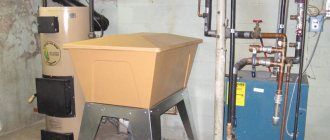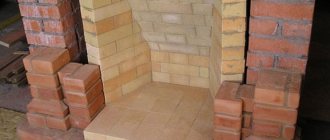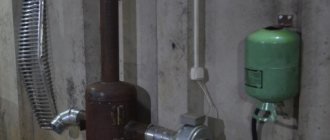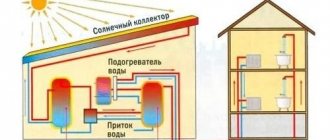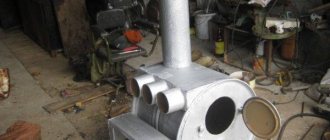The defining task when designing an autonomous heating system is the uniform distribution of the coolant. This task in the heat supply system is performed by a control and regulation unit - the distribution manifold.
The uninterrupted operation and reliability of the heating circuit largely depends on the correct choice of device, high-quality installation and connection. If you want to install a heating distribution manifold with your own hands, then you need to carry out calculations and design the wiring in advance.
We will help you resolve these issues. In the article, we examined the design of the collector group, identified the pros and cons of a heating system with a comb, and described the rules for the design and installation of a distribution unit.
The material is supplemented with practical advice on selecting components, assembling and connecting the collector to the heating system.
Functional purpose
Let's start with the fact that there is one very important rule, and if it is not strictly adhered to, the heating system at home will not work well.
This rule states that the diameter of the outlet pipe of a heating boiler should always be equal to or slightly less than the total diameter of all circuits consuming coolant. The best option is if it is larger.
For comparison, here is an example of a wall-mounted unit in which the diameter of the outlet pipe is ¾ inch. Imagine that this boiler will heat three separate circuits:
- The main heating is a radiator system.
- Warm floor.
- An indirect heating boiler that will use water intended for household needs.
Now imagine that each loop is at least ¾ inch in diameter, just like the boiler. But the total figure will be three times greater. That is, no matter how much you want, it will be simply impossible to dispense the required amount of coolant through the diameter of the heating boiler pipe so that it is enough for all three circuits. So much for the reduction in heat transfer throughout the entire area of the house.
Of course, individually all circuits will work fine. For example, the main circuit (radiator) without turning on underfloor heating will completely overpower the heated space. But as soon as you turn on the underfloor heating system, there won’t be enough coolant either here or there. The coolant has enough temperature, but its volume is not enough.
This rather serious problem is solved by installing a distribution manifold in the heating system. In essence, this is a structure made of stainless metal pipes, in the structure of which devices are installed for the input and output of coolant distributed along the circuits. To regulate temperature, pressure, flow volume and its speed, shut-off valves are installed along the terminals, which perform all the necessary functions.
The most important thing is that with the help of a distribution manifold you can control the temperature in a separate room. And this will not affect the neighboring rooms or the temperature of the house as a whole.
Collector device
The collector consists of two pipes:
- Connects the supply pipeline from the boiler to the supply circuits of heating systems. This compartment helps distribute hot water. Its device is especially helpful when the question arises of repairing a particular outlet. In this case, on a certain circuit where repair work needs to be carried out, the shut-off valve is closed. It simply shuts off the coolant supply.
- The return compartment regulates the pressure inside each circuit, which ensures the quality of coolant movement. And, therefore, the quality of heat transfer from heating systems.
Anyone who does not understand the essence of installing a distribution manifold begins to build various additional installations into the heating system: a circulation pump, valves for various purposes, and so on. Let's face it, this will not help; they cannot be used to increase the volume of coolant. You will simply make unnecessary expenses that will be in vain.
Attention! If you own a large multi-storey building, it is recommended to install a separate distribution manifold on each floor
General information
Today, collectors, which are popularly called combs, are used for the collective connection of a number of heating and plumbing fixtures.
Externally, this device is a cylindrical part with one input and many outlets. Each outlet is equipped with shut-off valves. The operating principle of this device is as follows: water or other liquid is supplied to the input under pressure. It is then distributed over taps that allow parallel connection of several plumbing fixtures or, for example, several circuits of a heated floor system.
The manifold connection allows you to ensure uniform water pressure in all plumbing fixtures when they are turned on at the same time. When using combs in heating systems, uniform heating of all heating devices (radiators or underfloor heating circuits) is ensured.
Scheme of using collectors in a heated floor system
Assembling a polypropylene comb with your own hands is quite simple, and for this you only need a set of tees and ball valves.
In this case, the device will have a number of advantages, such as:
Corrosion resistance. Tightness, as the fittings are securely welded to each other. Durability - virtually no scale deposits on the polypropylene walls of the fittings. Cheap, due to the fact that the price of polypropylene pipes and fittings is not high. Reliability, since polypropylene is a fairly durable material. The ability to perform exactly as many bends as required. The product can be used for both water supply and heating systems.
For these reasons, many experts prefer devices assembled independently from polypropylene parts to metal collectors.
Types of chimneys
Based on the material they are made of, chimneys are divided into aluminum, plastic, and stainless steel. Plastic and stainless steel are popular in Russia.
A gas boiler with a coaxial plastic chimney is usually condensing. The pipe is two-channel, made of heat-resistant plastic. Smoke temperature – up to 205 degrees. Such chimneys are inexpensive, lightweight, and easy to install. The downside is that the durability is not high enough.
Connection to non-condensing type boilers is not recommended, because their temperatures are higher. Conventional chimneys cannot be connected to condensation chimneys.
Stainless steel can withstand temperatures up to 550 degrees, it is durable and acid-resistant. These pipes can be insulated or non-insulated. When installing coaxial chimneys for two-channel gas boilers, thermal insulation is required. The first type has improved aerodynamics, can be used as a collective in an apartment building, and can be connected to boilers with an atmospheric burner. Durability – from 30 years.
The design of a vertical coaxial chimney for a gas boiler involves an outlet along the facade wall to the roof. In other cases, the pipe is routed through an outside wall and ends there.
Scheme of a vertical coaxial chimney:
Materials for production
To make a collector unit, you can use pipes: metal (round and rectangular) or polypropylene. The connection of the outlet circuits to the collector pipe is made through ball or valve valves, with the help of which the supply of coolant to each section of the heating system is regulated.
Polypropylene knot
For this, pieces of polypropylene pipe are used, for example, with a diameter of 32 mm (you can use leftovers from the construction of a heating system at home) and several fittings in the form of tees with dimensions 32/32/32 - it is installed at the end of the collector unit, and 32/32/16 - intermediate elements for connecting to outlet channels in sections.
Photo 1. A manifold for a heating system made of polypropylene. The red lines indicate the coolant flow.
The first tee is mounted perpendicular to the main pipe. Its two outer pipes, located vertically, are connected as follows: the air vent is connected to the upper one, and the drain valve is connected to the lower one. A valve or ball valve is mounted to the opposite end of the collector installation. A pipe will go from it towards the boiler.
The intermediate tees are connected into one structure, which will be called a manifold. Therefore, the manifold installation is first assembled by welding tees 32/32/16 with pieces of 32 mm pipes, after which a tee 32/32/32 and a tap are installed on the opposite side. Next, taps or valves for 16 mm pipes are connected to the intermediate fittings. It is with their help that the coolant supply to each circuit will be adjusted.
Advantages of a polypropylene device
First of all, it is necessary to note the low cost of the design, because for this you only have to purchase a small number of tees and taps. Other advantages:
- if the welding is carried out correctly, then such a structure will not leak;
- polypropylene is not subject to corrosion, does not rot and does not change its characteristics under the influence of water and high temperatures;
- light weight of the device;
- ease of installation.
From brass fittings
To assemble such an installation, fittings and valves made of brass are used.
To do this, you need to connect the same tees with double-sided couplings using a threaded connection with mandatory winding of a sealing material on the threads.
Moreover, if the threads on the tees are internal (which is most often the case), then the couplings must have external threads and tightening nuts.
The number of tees is the number of circuits, plus one. The latter is installed at the end of the manifold and is connected by two pipes to a drain valve and an air vent.
From a profile pipe
This is the most difficult process associated with metal welding. This requires skills and experience, because welding two pipes requires complete welding of the joint throughout the entire thickness of the products being connected.
It is recommended to first draw a sketch on paper with a precise definition of the location of the pipes. The pipes used are pipes with a diameter corresponding to the dimensions of the pipes of the outlet circuits. The parameters on paper are transferred to profiled pipes used as a collector. Their cross-section is either 80x80 or 100x100 mm.
Photo 2. Heating manifold made of profile pipes. Red indicates hot coolant, blue indicates cold fluid.
On one side of them are marked the locations of the pipes with a precise designation of the outer diameter. After that, holes are cut out with a gas cutter or plasma cutter. Spurs are welded to them strictly perpendicularly. At one end, the large pipe is closed with a metal plug (fastening is done by electric welding).
On the other side, a similar plug is installed, in which a hole is pre-cut for connection to a valve or tap. That is, the drive cuts into the hole. Welding areas must be cleaned with a metal brush to remove scale.
Two such elements are connected into one structure by installing metal profiles between them. One is connected to the coolant supply circuit, the second to the return circuit. It is better if you designate different groups with different colors: red is used for supply, blue for return.
Rules for choosing a retainer
The quality of the product affects its service life. Monolithic structures made from durable and reliable materials are considered the best. The limiters must be resistant to strong winds. A combination product is considered the ideal option. Because it will not break under heavy loads and will not rust under the influence of high humidity.
The metal fasteners are strong and reliable. But they look poor on the profile and corrode over time.
The screw holes in the handle must line up with the slots in the comb. The fittings must fit tightly to the surface. There are products that do not rise or fall completely. They cling to curtains and create additional interference.
Manufacturing methods
Before you start making a homemade collector, you need to select the material and prepare the necessary equipment. For example, to make a steel model you will need a welding machine. But don’t rush to choose polypropylene. In order to connect polypropylene parts, you will need a special device that is used to weld such pipes. Sometimes it is easier to get an ordinary welding machine than for plastic.
Calculation and distribution of contours
From the very beginning, you need to understand how many heating circuits you will need. It is necessary to take into account each existing heating device, so you will have to evaluate each room according to the list below.
To avoid forgetting anything, use the following list:
- the presence of a “warm floor” system;
- rooms that should have a higher or lower temperature compared to other rooms;
- floor heating;
- heating of each wing.
The rules for manufacturing a heating collector are as follows: the distance between the taps is 10-15 mm, the distance between the supply and return collectors is 25-30 cm.
The diameter of the pipes should be 12.7 mm. The collector itself is made with a diameter of 25.4-38.1 mm, depending on which boiler is installed.
Made from polypropylene
To make a polypropylene manifold assembly with your own hands, you will have to use leftover pipes and fittings.
You will need:
- pipe with a diameter of 32 mm;
- tees 32/32/16 mm.
A tee must be installed on one side. An air vent must be connected to it at the top, and a drain tap at the bottom. On the other side, a valve and pipe are attached. The pipe can be supply or outlet, depending on the purpose of the collector. The supply pipe goes to the boiler.
The remaining outlet with a diameter of 16 mm must be equipped with a valve or flow meter, depending on which collector is for water supply or outlet. At this point the work is completed, and all that remains is to secure the resulting collector systems to the wall using brackets.
Assembly of brass fittings
If a ready-made brass manifold is quite expensive, then you can spend much less money on a homemade one. To build such a structure you will need tees and fittings. They are connected to each other using linen tow or a liquid fixative as a cushioning material. The parts must be connected according to the assembly diagram. An example can be seen in the picture below.
After the collector is assembled, it must be tested. It is difficult to make the connection correctly, so the likelihood of leaks is high.
From a profile pipe
Making a collector from pipes with different cross-sections is the most difficult, since it will require welding work. This model can be called the most “sophisticated”. It is suitable for heating large areas and can have many pipe connections. Often such samples are equipped with a hydraulic arrow.
The following samples will be needed:
- profile pipe 8x8 cm or 10x10 cm;
- round pipe.
The calculation of the pipe cross-section is performed in special programs. It is necessary to set the required heating thermal power, water speed, temperature difference between supply and return.
In this case, you will need to build a circuit, taking into account the number of circuits. Remember that the distance between wiring should be about 15 cm, and between collectors - at least 20 cm. A typical diagram looks like this.
Next, you need to mark a pipe with a rectangular cross-section according to the diagram, and then make holes for wiring using a gas cutter. Weld pre-prepared small parts of threaded pipes to the holes. The block is ready, all that remains is to weld the brackets to it, prepare it and paint it.
Subtleties of self-assembly
Before manufacturing the collector, it is necessary to draw up a diagram showing the location of all the elements of the assembly. It is better to choose steel pipes with a square cross-section as the manufacturing material. This type is easy to process, which significantly reduces labor costs for installing pipes.
Manifolds made of profile pipes are used in the heating circuit of objects with a large number of circuits and a hydraulic separator. Square pipe parameters – 80*80 or 100*100 mm
The step-by-step process for producing a prefabricated distribution structure is as follows:
- Marking and cutting of the main body . According to the design diagram, it is necessary to mark the profile pipe. Using a gas cutter, holes are made in the marked areas.
- Preparing connections . The pipes are threaded using a die.
- Staffing . Next, the prepared pipe sections are welded to the body. Their fixation must be done by tack spot welding. Then, during the main welding, the workpieces are welded along the edges.
- Fastening elements . Brackets for fastening are welded to the block.
- Cleaning and finishing . After cleaning, the body is primed and coated with heat-resistant paint for metal products. The supply and return circuits are painted in two different colors for ease of identification.
If polypropylene pipes are used for production, you should pay attention to the presence of a reinforcing layer in them. In its absence, the plastic structure may be subject to deformation due to the current temperature conditions.
For those who do not have special tools, you can assemble a comb from separate ready-made elements. It is better to select components from one company.
How the collector works
A group of room heating circuits are brought together. The point of their connection is the collector. Essentially, a manifold for a heated floor is a distribution and mixing unit for performing the following functions:
- regulation of the temperature of the coolant that passes through the boiler heater. (It is enough to supply coolant heated to 45 °C to the underfloor heating system, but this temperature value is low for the heater; usually the minimum value at the inlet to the collector is about 55 °C);
- ensuring the necessary supply of heat energy in each room. In this case, it functions as a mixer and coolant energy regulator for each heating circuit
The distribution point for heating circuits is a system consisting of two collectors. It includes a manifold for supplying coolant to the system and a return manifold through which cooled coolant flows. They have pipes through which heated coolant flows from the boiler and cooled coolant is supplied to the boiler for heating. A typical manifold for underfloor heating is shown in the figure below:
The amount of heat entering each circuit is regulated by means of valves with a pressure rod. The design of such regulators allows for energy distribution, both manually and using automation tools, controlled remotely. Heat consumption in the system is controlled by a group of flow meter bulbs. Let's take a closer look at this device:
Please note that the circuit uses a circulation pump. This allows the heating circuit to function more efficiently, since there is not always a need for a high coolant temperature, which simultaneously creates pressure for circulation in the system
The disadvantage is the loss of functional advantage when the power is turned off. In this case, the group of heating circuits becomes incapacitated.
Let's consider the principle of operation of the collector. The coolant received from the boiler heating register carries a certain amount of heat to each circuit of the system through the operation of the circulation pump. This happens when the coolant temperature is higher than the specified value. When the temperature in the system decreases, the three-way valve opens and another portion of heat is added to the system.
When the threshold of the set temperature is reached, the sensor signal will enter the control system, and the three-way valve will shut off the addition of hot coolant.
The circulation pump, operating continuously, and the group of circuits are ensured by the constant movement of the coolant.
To carry out routine maintenance, as well as in case of dismantling, drain taps are provided in the collector.
To prevent airing of the system, air vents can be introduced into the circuit. There is a group of air vents that allow you to automate this process.
Operating principle of two-way valve
When using a connection diagram for a comb with a two-way valve for a heating floor, the design is equipped with a temperature sensor, it is located on the return line. The valve can be in an open or closed position, it depends on the rod that is controlled by the thermal head.
The operating principle of the device is determined by the opening of the valve, resulting in the flow of heated liquid from the boiler into the comb.
There it is diluted with cooled coolant, and then sent to the supply pipe. At this moment, the thermometer measures the temperature level of the liquid; if it is lower than required, the rod remains open.
When the desired temperature is reached, it closes and hot water stops flowing. When the coolant cools down in the heated floor, the thermal head raises the rod, thereby opening and resuming the supply.
The two-way valve is reliable, the possibility of breakage of the shut-off element is almost zero, so the risk of an excess portion of heated liquid entering the heated floor is minimal. However, it is worth saying that the control process - smoothness and accuracy - is inferior to three-way valves.
A manifold with a two-way valve can heat a room with a limited area - no more than 200 m2. The device is not suitable for heating large rooms.
As an advice
In order to avoid an unesthetic appearance, as in the figure below, it is necessary to carefully approach the issue of pipe lengths when preparing them.
As an example of good work when assembling the distribution unit, the photo below is shown:
To achieve this result, it is necessary to select the length of the nipples from the pipes, which will ensure a tight fit of the tees.
The photo shows arrows indicating the direction of movement of the coolant. As a rule, it is good form if this is done directly on the pipeline. This makes the distribution node diagram easier to read and understand.
After completing the assembly of the assembly of tees and pipes, it must be secured to the wall. Then you can install the remaining elements: circulation pump, taps, blowers, valves
It is important to remember that heavier parts should be secured directly to the surface and not place stress on the assembly. If necessary, flow meters and control elements can be added to the distributor
Such products can be purchased separately.
What does the comb consist of?
Having decided on the adjustment method, having decided whether a three-way valve or thermal heads will be used, the remaining elements of the comb are assembled.
- The collector itself is two parallel tubes (supply and return) with outputs. One side of each comb is plugged. It can be purchased ready-made, but its cost is the main cost of the mixing unit (we are talking about thousands of rubles). It is much cheaper to assemble a comb from a series of tees, which have an internal thread on one side and an external thread on the other. The circuit tubes are connected to the side outlets (via fittings - crimp or solder).
- Manometer that controls pressure.
- A burst valve that will operate if the pressure is exceeded.
- Servo drives for each circuit are especially important when the length of the circuits is different (if you give free rein to the laws of physics, the temperature in them will be significantly different). Thermostats equalize pressure and temperature.
Modifications of collector units
Before you begin assembling the collector assembly, it is necessary to determine its functional load. The equipment can be installed in several sections of the heating main. Based on this, the necessary equipment, dimensions and level of automation of the work cycle are selected.
In fact, for the full operation of such a node, two devices are needed. Using a comb, the coolant is distributed along the contours of the central supply pipeline. The return collector channel is represented by a collection mechanism and the point of departure of the cooled liquid into the boiler.
The collector heating circuit is selected based on the calculation of the required functionality and installation location. The choice of material for making the device does not affect the number of significant mechanisms
Installation of a homemade distribution group may be required when installing water-heated floors or for preparing standard heating with radiators.
Distinctive features of both options are their sizes and components:
- Boiler room. The welded manifold group is made of pipes with a diameter of up to 100 mm. A circulation pump and shut-off valves are installed on the supply side. The return ring is equipped with shut-off ball valves.
Each of these solutions provides an individual installation scheme. Correct installation of all elements can be carried out only after detailed calculations of all operating point parameters.
The comb can be made of the same material as the pipeline. If it is different, adapters will be used to connect the collector
There are also differences in the required number of circulation pumps. In the boiler room, each line is equipped with this device. For heated floors, only one installation is provided.
Automatic temperature control of TP
Automatic adjustment of a heated floor can be carried out thermomechanically or electronically using electromechanical actuators that control the operation of shut-off valves.
Thermomechanical control system
It is based on the operation of thermostatic valves or taps with thermal heads that respond to changes in coolant temperature. Various models of such shut-off and control valves are offered today by many manufacturers, for example, Oventrop. However, regardless of the name and type of thermosetting substance used in them (liquid or gas), these are thermomechanical self-regulating mechanisms that are most appropriately installed to control the temperature of one, individual circuit.
The operating principle of thermal valves is simple, which makes them very reliable and fault-tolerant. A copper, brass or bronze core installed in the device body, heated by the passing coolant flow, transfers the temperature to the thermosetting filler. In turn, the thermosetting element, which increases in volume, pushes the core, which, by moving the valve, gradually blocks the circulation of the heated liquid.
The thermostatic valve for heated floors, in addition to being installed on the distribution comb, can be mounted in a separate “unibox” type assembly. Such assemblies also include automatic air vents, which, together with thermostats, are placed in compact boxes (boxes). The use of a “unibox” allows you to adjust the temperature in a separate branch of the TP without being tied to bulky manifold cabinets, which is especially convenient with a small number of circuits.
In addition, thermomechanical floor heating controllers can have remote air sensitive elements. They allow you to configure them to control the flow of coolant not according to its temperature, but according to the air temperature in the rooms. The principle of their operation is the same, only the thermosetting substance is much more sensitive. It is advisable to install an air thermal head for simultaneous control of several circuits in one room, where water underfloor heating is the only source of heating.
Electronic control system
It consists of electronic thermometers, a controller and electric drives (actuators, servos). Electric drive mechanisms can be attached to the mixing heads of conventional control valves (valves) or be part of their design. The change in coolant supply intensity is carried out in accordance with specified threshold values. The measuring medium for the temperature sensors of the automatic floor heating temperature controller can be both the coolant and the air in the premises.
Necessary materials and equipment
So, to connect a warm water floor you will need:
- special pipes;
- collector;
- thermal insulation.
All these materials and equipment are equally important in the structure of a warm water floor. Let's talk about each point in detail
Pipes
In order to install a warm water floor, you will need pipes reaching two centimeters in diameter. As for the pipe material, reinforced polyethylene or multilayer (or otherwise metallized) pipes are suitable. Ideally, pipes should have an anti-oxygen coating.
Why is it better to choose pipes made from synthetic materials? Firstly, it will be easier for you to install just such pipes with your own hands, and secondly, the inner surface of pipes made from such materials is smooth, they do not cause electrochemical corrosion.
How to calculate how many pipes it will take to install a warm water floor? It's not difficult at all! If the distance between the pipes is 20 centimeters, then for each square meter of living space it is necessary to take five meters of linear pipes
Please note that the longest continuous length of the so-called “loop” in the system is 80-120 meters
While you are installing the pipes with your own hands, pay attention to the fact that next to the walls and windows the pipes must be laid more tightly, at a distance of not 20, but 10-15 centimeters from each other. Ideally, you can also plan how the furniture will be arranged in the living space after the renovation work is completed. For example, if you want to install a stationary cabinet in a room, then you don’t have to lay pipes under it
For example, if you want to install a stationary cabinet in a room, then you don’t have to lay pipes under it
Ideally, you can also plan how the furniture will be arranged in the living space after the renovation work is completed. For example, if you want to install a stationary cabinet in a room, then you don’t have to lay pipes under it.
The rules for connecting a warm water floor also require compliance with the following parameters:
- the operating pressure should be approximately 10 bar (1 bar error allowed);
- The highest coolant temperature should be +100 °C.
Collector
The manifold is the most complex part of a heated floor. The complexity of this object is also reflected in its price, so it is a reasonable decision to make the collector yourself. The type of collector depends on the number of pipe inlets and outlets.
Thermal insulation
As for thermal insulation boards, they can be equipped with pipe clamps or have markings. When using foam plastic during installation, it must be covered with waterproofing, that is, a polyethylene film.
Why is thermal insulation needed? It is necessary so that the heat does not escape downwards, otherwise you will heat the floors between floors. Thermal insulation must completely cover the entire floor of the living space.
In addition to the above materials and equipment, installation of heated floors will also require:
- fittings to connect pipes and manifold;
- a reinforcing mesh made of metal with cells measuring approximately three to five centimeters (the mesh is necessary to fill the screed);
- pipe fasteners;
- damper tape (the required length of the tape is equal to the perimeter of the room).
What types of combs are there?
In appearance, all crocodiles are very similar to each other and consist of a plate with notches and a retainer. The distance between the recesses can be from one to seven centimeters. There are several varieties of crocodiles. They differ by company, country of manufacture and technical characteristics.
Classification by manufacturer
Imported and domestic products are available for sale. Foreign-made products are mounted in a profile, which allows them to be mounted at any height. In addition, their surface is covered with a rubberized layer, so even in very windy weather there will be no rattling. But it is not recommended to mount them on wooden frames. Because strong gusts of wind create an increased load, which causes cracks to appear.
Domestic models do not have a rubberized layer and can only be attached to the surface. The limiter itself is elongated, which makes it less convenient to use. You can understand the differences from the photo.
Classification according to product characteristics
Blockers are grouped based on the following indicators:
- Material . They are made of metal, plastic, or a combination of these materials.
- Color . The products are painted in different shades, but their variety is small. Therefore, if the desired option is not available, you can repaint the retainer in a different shade.
- Mounting method . The fittings can be screwed to the handle, to the sash or to the back of the window frame.
- Number of grooves . There may be different numbers of them.
- Length . There are no strict standards regarding length. A product with four holes reaches a length of up to 10 cm, and with five - up to thirteen centimeters.
Different blocker models serve the same purpose. All of them are used to fix and stable the position of the sash during strong gusts of wind. Combined models are considered the best. The metal base will provide strength, and the plastic will protect against corrosion. A frame with such fittings looks aesthetically pleasing.
According to the method of fastening, the most convenient is the floating mounted crocodile. It can be installed in any part of the frame, regardless of the location of the handle. This feature of the comb allows it to be installed even in cases where the pressing mechanism of another sash interferes.
The mechanism of action of the crocodile is compared to how a door chain works. It is an important element of the window opening in houses with small children and animals.
Installation nuances
The technology for attaching the collector to the wall is quite simple: the TC and radial distribution comb are suspended on mounting brackets, the loops are connected with Eurocone fittings. Pipes going to the top of the collector (usually the “return”) are passed under the bottom.
Advice. No one is forcing you to mount the distributor on brackets. If necessary, the tubes can be spread apart and mounted separately on the wall. The collector box is used in residential areas; when installing the collector in the boiler room, the cabinet is not needed.
Let's briefly list the main points:
- The size of the comb is selected according to the diameter of the pipes used in the heating loops - Ø16 or Ø20 mm. Accordingly, we take a ¾ or 1 inch distributor. The material of the product does not matter; in terms of price/quality ratio, stainless steel wins.
- If the number of comb outlets exceeds 12, assemble a collector assembly of 2 sections. When installing accessories, winding materials are not used, since the parts are equipped with rubber seals.
- A heavier common house collector is suspended on hooks, reinforced brackets, or installed on the floor. Pumps, pipes and other piping elements must not load the distributor with their own weight.
- The hottest coolant receives an indirect heating boiler. The coil and circulation pump of the water heater are connected to the comb directly, usually from the end.
- The radiator heating and TP branches are connected to the manifold through mixing units with three-way valves. A separate pump is installed on each line, selected for pressure and performance.
Installing a comb on a plastic window
You can order the installation of a comb when installing new windows. But if the window frames are already in place, then you will have to do this work yourself. Before you begin the task, you need to figure out what type of mount is provided on a particular crocodile and how to install it correctly. This can be installed under the handle or at the end of the frame. In both cases, the plate with grooves is installed on the fixed part of the profile, and the latch is on the sash.
It is easier for an inexperienced person to attach the fittings under the handle. Any person without special skills and knowledge can perform installation. Installation using any other method will require the help of specialists. Overlap installation requires special skills and knowledge of how to install fittings. If installed incorrectly, the window seal will be compromised.
Consumers prefer fasteners with flush mounting. It has one significant advantage in the form of the ability to be installed in any part of the frame.
The comb is attached to the frame, and the corkscrew is near the handle for locking. The installation process is carried out in stages. First, remove the handle. Then you need to install the lock and screw the handle into place. At the same level where the blocker is installed, a crocodile is attached to the frame profile. After completing all the work, check that nothing interferes with closing the window.
Watching the video will help you make the correct installation. If the comb fails, you will have to reinstall it.
Main characteristics of the collector system
The main difference between the collector and standard linear method of redistribution of the coolant is the division of flows into several channels independent of each other. Various modifications of collector installations can be used, differing in configuration and size range.
The collector heating circuit is often called radiant. This is due to the design features of the comb. When examining the device from the top point, you will notice that the pipelines extending from it resemble an image of sun rays
The design of the welded manifold is quite simple. The required number of pipes is connected to the comb, which is a round or square pipe, which, in turn, are connected to individual lines of the heating circuit. The collector installation itself is interfaced with the main pipeline.
Shut-off valves are also installed, through which the volume and temperature of the heated liquid in each of the circuits is regulated.
A manifold group, complete with all the necessary parts, can be purchased ready-made or assembled independently, which will significantly reduce the cost estimate when designing heating
The positive aspects of operating a heating system based on a distribution manifold are the following:
- The centralized distribution of the hydraulic circuit and temperature indicators occurs evenly. The simplest model of a two- or four-circuit ring comb can balance the indicators quite effectively.
- Regulation of heating main operating modes. The process is reproduced due to the presence of special mechanisms - flow meters, mixing unit, shut-off and control valves and thermostats. However, their installation requires correct calculations.
- Ease of maintenance. The need for preventive or repair measures does not require shutting down the entire heating network. Due to the sliding pipeline fittings mounted on each individual circuit, you can easily shut off the coolant flow in the required area.
However, there are also disadvantages to such a system. First of all, pipe consumption increases. Compensation for hydraulic losses is carried out by installing a circulation pump. It must be installed on all collector groups. In addition, this solution is only relevant in closed-type heating systems.
Rules for selecting components
Having completed all the calculations, the next step is to select the required set of mechanisms. The simplest set consists of shut-off valves. However, with such a device it is difficult to regulate the power of individual heating lines.
To solve this problem, crane axle boxes are installed on the feed comb, through which smooth adjustment is possible. Rotameters are mounted on the return manifold.
The collector parameters must be sufficient for convenient access to shut-off and control valves. The average range between the contours is 100-150 mm, the center distance between the feed and return combs is 250-300 mm
For warm water floors, the configuration scheme will be different.
For assembly you will need the following elements:
- Shut-off and control valve. Installation is carried out on connecting pipes. With the help of this fittings, the flow of coolant is completely or partially stopped. It is recommended to use automatic modification.
- Rotameters . Such elements are mounted on the return collector. They perform a similar function as the previous element, only in the return pipeline.
- Mixing unit . By mixing hot and cold water flows, the specified heating operating mode is optimized.
The manifold kit is necessarily equipped with a safety group headed by a pressure gauge, air valve, thermostat and circulation pump. It can be supplemented with servo drives, the control of which is reproduced through the control electrical unit. Thus, the operation of the system can be automated.
What is a heating collector
The device is structurally made in the form of a metal comb, equipped with several “input-output” points, which autonomously connect heating batteries to the in-house coolant.
The purpose of this connection is to adjust and control heating parameters:
- volume of network water;
- network temperatures;
- pressure in the supply and return networks.
The design of the heating unit controls heat transfer and ensures sanitary and hygienic living standards in the premises.
Important! For heating installation in two-story buildings, the unit is mounted on each floor, thus implementing a high-quality heat supply scheme with floor-by-floor regulation
Boiler repair
In case of leakage, we repair fire tube boilers in the following sequence:
- We study the documentation and diagrams of the device.
- We search for the problem area and localize it.
- We clean the surface near the crack to bare metal to a width of 15-20 mm.
- We carry out welding work at ambient temperatures above +5C. We use electrodes with a thickness of 2.5 mm or 3 mm. We weld the seam from the side of the drum 2-4 mm larger than from the pipe. The welding direction is from the middle of the crack to the edges using two welding machines simultaneously.
- We clean the seam until it shines and look at its quality. If necessary, we eliminate deficiencies: uncooked areas and shells.
- We test the boiler.
Fire-tube water-heating boilers are used in boiler houses, for heating private households, in industry and other areas.
Sometimes in the construction of fire-tube boilers, due to improper operation, it becomes necessary to replace the damaged section. For these purposes, the gas-flame method is used. In this case, the dimensions of the damaged part must be at least 200 mm or the diameter of the pipe. First, they localize the area, then cut it out with a grinder until the thickness and properties of the metal are preserved, after which they clean and weld a patch made of steel of the same composition.
Fire-tube water heating boilers are used in boiler houses, for heating private households, in industry and other areas. This is due to their high heating efficiency and economical fuel consumption, reliability and ease of operation. The design of fire tube boilers is relatively simple, so they can be easily repaired even independently without the involvement of specialists.
Advantages
When using underfloor heating combs, you can get a number of advantages:
- Energy savings compared to conventional radiator use. Its value can be from thirty to fifty percent.
- High degree of safety during operation. There are no fire-hazardous open heating elements.
- Greater durability. The service life can be two decades or more.
- High comfort of heating the apartment and the absence of areas with uneven heating.
- The aesthetics of the design used. The system takes up little space and is usually mounted in a special small cabinet.
- Hygiene. Keeping the floor warm makes wet cleaning easier and eliminates the destructive effects of excessive humidity. This, in turn, makes it impossible for fungi or mold to form.
- Safety from burns. In the absence of such a heating control system, hot water can be used. When touching pipes, not only children, but also adults can get burned. A comb for heated floors allows you to qualitatively regulate the temperature of the coolant, avoiding its excessive heating.
How to make a heating collector with your own hands?
Today, the main requirement for heating systems is their energy efficiency. The optimal heating options are considered to be connection diagrams for heating devices that provide a comfortable microclimate in the house during the winter cold, and also guarantee rational consumption of energy resources, affordable heating costs and rationality. The collector heating system of a private house, which has other advantages, fits this description. These include practicality, functionality, ease of use and reliability.
Setting up a comb for heated floors
Factory products undergo bench testing, as evidenced by accompanying documents containing complete information about all hydrotests performed under special conditions. The use of such compact devices with a guarantee of tightness of welded and threaded connections is the best option in any in-house heating systems. Such units are characterized by an ergonomic arrangement of controls, and installation inside special mounting cabinets does not interfere with access to control valves.
The coolant from the supply pipe and the return pipe is mixed inside each outlet or directly in front of the collector, but it is advisable to entrust the calculation of the optimal circuit to specialists.
Regulating the temperature of the floor surface involves performing several sequential actions:
- Set the bypass valve to max, moving it to the 0.6 bar position. Triggering this node during the setup process causes an erroneous result.
- Calculate the balancing valve, using for this purpose the temperature indicators at the return, supply line and outlet of the heating device, under the conditions of a standard coefficient of 0.9 and according to the throughput formula: K = 0.9 × [(tk – to/tp – to) - 1]).
- Set up pumping equipment by calculating the boiling water flow rate and pressure loss on the circuits. It is allowed to set the minimum feed with a gradual addition of speed.
- Balance the branches by fully opening the control units and smoothly closing them to the required position.
At the final stage of setting up the comb for the “warm floor” system, the flow rate of the mixing unit is linked with other heating devices.
It should be noted that installing a flow meter will greatly facilitate obtaining accuracy when setting up all components. It is recommended to set the processing parameters of the bypass valve device approximately ten percent lower than the established maximum pressure values of the pumping equipment.

